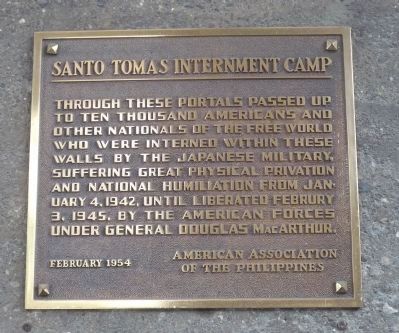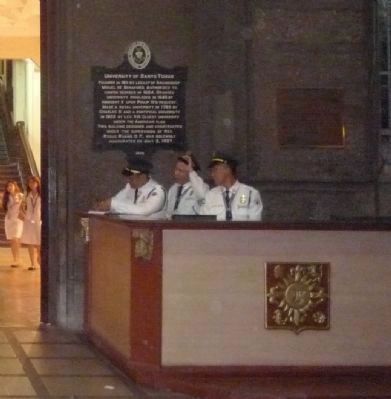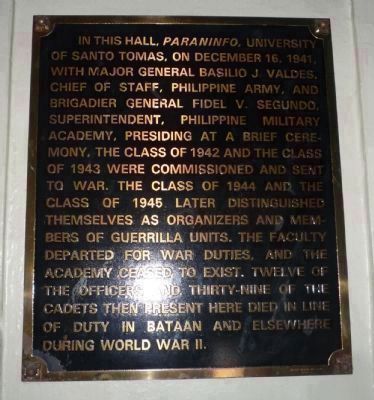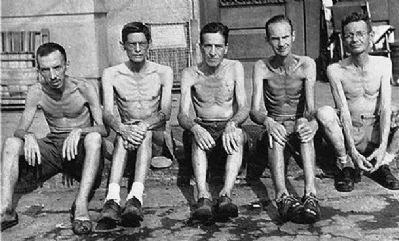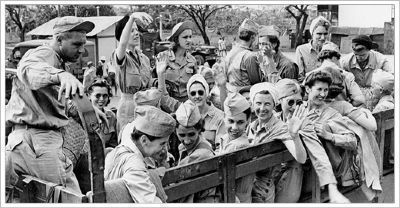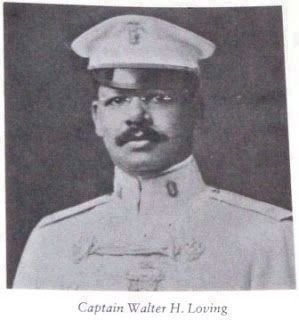Sampaloc in Manila, Metro Manila, Philippines — Southeast Asia
Santo Tomas Internment Camp
Main Building, University of Santo Tomas
Through these portals passed up to ten thousand Americans and other nationals of the free world who were interned within these walls by the Japanese military. Suffering great physical privation and national humiliation from January 4, 1942, until liberated February 3, 1945, by the American Forces under General Douglas MacArthur.
Erected 1954 by American Association of the Philippines.
Topics. This memorial is listed in these topic lists: African Americans • War, World II. A significant historical month for this entry is January 1939.
Location. 14° 36.587′ N, 120° 59.372′ E. Marker is in Manila, Metro Manila. It is in Sampaloc. Memorial is on Plaza Major just north of España Street, on the right when traveling west. at the front entrance to the UST's "Main Building" on the north side of the Plaza Mayor which is at the center of the campus - bounded on the northwest by Osmeña Drive and on the southeast by Quezon Drive. Touch for map. Marker is at or near this postal address: ESpaa, Sampaloc, Manila, Philippines, Manila, Metro Manila 1008, Philippines. Touch for directions.
Other nearby markers. At least 8 other markers are within 3 kilometers of this marker, measured as the crow flies. University of Santo Tomas (here, next to this marker); a different marker also named University of Santo Tomas (within shouting distance of this marker); William J. Burke (approx. 1.7 kilometers away); Roman Ongpin (approx. 1.9 kilometers away); Ang Simbahan ng Binondo (approx. 2 kilometers away); Philippine Post Office (approx. 2 kilometers away); Our Lady of the Most Holy Rosary Parish Church (approx. 2 kilometers away); The New Plaza San Lorenzo Ruiz (approx. 2 kilometers away). Touch for a list and map of all markers in Manila.
Related markers. Click here for a list of markers that are related to this marker. To better understand the relationship, study each marker in the order shown.
Also see . . .
1. Santo Tomas Internment Camp. ... The number of internees in February 1942 amounted to 3,200 Americans, 900 British (including Canadians, Australians, etc.), 40 Poles, 30 Dutch, and individuals from Spain, Mexico, Nicaragua, Cuba, Russia, Belgium, Sweden, Denmark, China, and Burma. About 100 of the total were Filipino or part-Filipino, principally the spouses and children of Americans. Of the Americans, 2,000 were males and 1,200 females, including 450 married couples. Children numbered 400. Seventy African-Americans were among the internees as were two American
Indians, a Mohawk and a Cherokee. The British were divided about equally between male and female. The imbalance in gender among the Americans was primarily due to the fact that, anticipating the war, many wives and children of American men employed in the Philippines had returned to the US before December 8, 1941. A few of the women and children had been sent to the Philippines from China to escape the war in that country. Some had arrived only days before the Japanese attack. ... (Submitted on March 20, 2013, by Richard E. Miller of Oxon Hill, Maryland.)
2. Lt.Col. Walter H. Loving, Philippine Army. Afro-American soldier, Philippine-American War veteran, acclaimed musician, composer, and martyr. He organized and directed the world-renowned Philippine Constabulary Band prior to WWI. Retiring in Commonwealth, he was interned with his wife, Edith at the Santo Tomas camp in 1942. Eventually allowed to return to the couple's home in Ermita due to his declining health, he and Edith became separated during the Battle of Manila in 1945. He was seized and killed by Japanese soldiers, and his remains were never recovered. (Submitted on March 21, 2013, by Richard E. Miller of Oxon Hill, Maryland.)
Additional keywords. Battle of Manila; 1st Cavalry Division (U.S.A.); Walter Loving;
Paraninfo
Credits. This page was last revised on February 12, 2022. It was originally submitted on March 20, 2013, by Richard E. Miller of Oxon Hill, Maryland. This page has been viewed 1,565 times since then and 51 times this year. Last updated on April 2, 2014, by Richard E. Miller of Oxon Hill, Maryland. Photos: 1, 2, 3. submitted on March 20, 2013, by Richard E. Miller of Oxon Hill, Maryland. 4, 5, 6. submitted on March 21, 2013, by Richard E. Miller of Oxon Hill, Maryland. • Bill Pfingsten was the editor who published this page.
